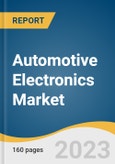The global automotive electronics market size is expected to reach USD 468,165.7 million by 2030, expanding at a CAGR of 8.6% during the forecast period. Increased safety and security concerns would fuel demand for car electronics as governments around the world try to reduce the number of road fatalities. The growing need for driverless automobiles, electric vehicles, and cutting-edge vehicle technologies is also anticipated to drive the automotive electronics industry. Some of the notable technologically cutting-edge features that are anticipated to fuel market expansion throughout the forecast period include alcohol ignition interlocks, emergency call systems, and accident data recorder systems.
Advanced safety systems with functions like automated emergency braking and blind-spot recognition are now more widely used since they are more affordable. The use of automotive ECUs and sensors used in these systems is then anticipated to increase, driving the growth of the automotive electronics industry throughout the course of the forecast period. Additionally, these characteristics follow government laws and policies and are thought to open the door for the adoption of autonomous vehicles. The electronic operations in these vehicles are controlled by ECUs and sensors, which raises the need for these parts.
The automotive electronics industry is also affected by the recent semiconductor chip shortages globally. The automakers have been severely impacted by the shortage of semiconductor chips, which has forced them to temporarily cease production in their facilities as a result of the pandemic supply-chain gyrations and escalating demand. In April 2021, General Motors and Ford announced plans to temporarily shut down their factories due to a shortage of semiconductor chips. The chaotic ordering from the automotive OEMs makes it harder for chipmakers to understand where they need to allocate supply to meet real and short-term needs.
The Asia Pacific regional market captured around 41.3% of the overall automotive electronics demand in 2022 and is estimated to register the highest CAGR of 9.0% over the forecast period. The demand in Asia Pacific is largely fulfilled by China, India, and Japan. China is the world's largest manufacturing hub and one of the fastest-growing economies. The Chinese automotive manufacturers are leveraging favorable market conditions to take the lead and dominate the market. Moreover, the Make in India campaign is expected to draw investments in the automotive sector, thus boosting the demand for automotive electronics.
Advanced safety systems with functions like automated emergency braking and blind-spot recognition are now more widely used since they are more affordable. The use of automotive ECUs and sensors used in these systems is then anticipated to increase, driving the growth of the automotive electronics industry throughout the course of the forecast period. Additionally, these characteristics follow government laws and policies and are thought to open the door for the adoption of autonomous vehicles. The electronic operations in these vehicles are controlled by ECUs and sensors, which raises the need for these parts.
The automotive electronics industry is also affected by the recent semiconductor chip shortages globally. The automakers have been severely impacted by the shortage of semiconductor chips, which has forced them to temporarily cease production in their facilities as a result of the pandemic supply-chain gyrations and escalating demand. In April 2021, General Motors and Ford announced plans to temporarily shut down their factories due to a shortage of semiconductor chips. The chaotic ordering from the automotive OEMs makes it harder for chipmakers to understand where they need to allocate supply to meet real and short-term needs.
The Asia Pacific regional market captured around 41.3% of the overall automotive electronics demand in 2022 and is estimated to register the highest CAGR of 9.0% over the forecast period. The demand in Asia Pacific is largely fulfilled by China, India, and Japan. China is the world's largest manufacturing hub and one of the fastest-growing economies. The Chinese automotive manufacturers are leveraging favorable market conditions to take the lead and dominate the market. Moreover, the Make in India campaign is expected to draw investments in the automotive sector, thus boosting the demand for automotive electronics.
Automotive Electronics Market Report Highlights
- In terms of component, the sensors segment is estimated to expand at the highest CAGR of around 9.9% over the forecast period. This can be attributed to favorable government initiatives for passenger safety and security in various regions
- In terms of application, the safety system segment emerged as the largest segment in 2022. Increasing customer awareness about technological changes related to safety equipment in vehicles is expected to act as a potential driver for the growth of the safety systems segment
- In terms of sales channel, OEM emerged as the largest segment in 2022 owing to the increased durability and shelf-life of electronic components
- The Asia Pacific regional market held the largest revenue share in 2022. This can be attributed to the increasing production of vehicles in India, China, and Japan.
Table of Contents
Chapter 1 Methodology & Scope
Chapter 2 Executive Summary
Chapter 3 Market Variables, Trends, & Scope
Chapter 4 Automotive Electronics Market: Component Estimates & Trend Analysis
Chapter 5 Automotive Electronics Market: Application Estimates & Trend Analysis
Chapter 6 Automotive Electronics Market: Sales Channel Estimates & Trend Analysis
Chapter 7 Automotive Electronics Market: Regional Estimates & Trend Analysis
Chapter 8 Competitive Landscape
List of Tables
List of Figures
Companies Mentioned
- CONTINENTAL AG
- DENSO CORPORATION
- Hella Gmbh & Co. Kgaa (Hella)
- Infineon Technologies AG
- Robert Bosch GmbH
- Valeo Inc.
- ZF Friedrichshafen AG
- Hitachi Automotive Systems, Ltd.
- Visteon Corporation
- Xilinx, Inc.
Methodology

LOADING...
Table Information
| Report Attribute | Details |
|---|---|
| No. of Pages | 160 |
| Published | March 2023 |
| Forecast Period | 2022 - 2030 |
| Estimated Market Value ( USD | $ 244954.5 Million |
| Forecasted Market Value ( USD | $ 468165.7 Million |
| Compound Annual Growth Rate | 8.6% |
| Regions Covered | Global |
| No. of Companies Mentioned | 10 |









